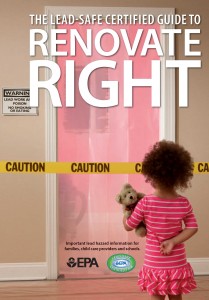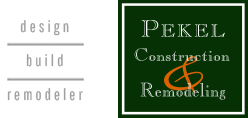Updating Your Pre-1978 Home and Lead Safe Work Practices
You’ve finally made the decision to finally remodel the outdated kitchen and family room of your home. Yeah! But if you live in a house built before 1978, a federal law regulating the removal of lead paint may affect your home remodeling project.
In 1978, the use of lead paint was officially banned from residential construction. Before that, however, lead paint was used in more than 38 million homes, according to the U.S. Environmental Protection Agency (EPA).
Beginning in April 22, 2010, contractors performing renovation, repair and painting projects that disturb lead-based paint in homes, child care facilities, and schools built before 1978 must be certified and must follow specific work practices to prevent lead contamination.
 The Dangers of Lead Paint
The Dangers of Lead Paint
During a renovation or remodel, dust from lead paint removal can fill the air and be breathed in or small children could ingest lead paint chips that fall from the wall. For young children, lead poisoning can cause learning disabilities, hearing loss and behavior problems. In adults, lead poisoning can lead to hypertension and high blood pressure. Pregnant women run the risk of passing the poison on to their unborn child.
It is important that you find a remodeler who is trained in lead-safe work practices rather than try to do the work yourself. To ensure the safety of the home’s occupants, the EPA’s new regulation requires that any major renovation to homes built before 1978 must be performed by a certified lead safe remodeler or renovator employed with a certified lead safe company.
What are Lead-Safe Work Practices?
EPA has a free brochure on their website called “Renovate Right”, which provides guidance to homeowners and contractors about the safe removal of lead paint. Your contractor should follow the specific work practices prescribed by the EPA RRP Rule.
http://www.epa.gov/lead/pubs/renovaterightbrochure.pdf
Who needs this?
Anyone who is doing work for compensation on a home or child occupied facility built pre‐1978 that is…
- Replacing window(s) (It does not matter if replacement does not fall into square feet requirements below, window(s) are always included).
- Disturbing more than 6 square feet of interior painted or coated lead contaminated surfaces.
- Disturbing more than 20 square feet of exterior painted or coated lead contaminated surfaces.
What do contractors need to do?
- Complete an 8 hour Wisconsin accredited “Lead Safe Renovation Course” or an 8 hour out of state EPA accredited “Lead Safe Renovation Course”
- Certify your Firm.
- Fill out the Wisconsin Department of Health Services “Lead‐ Based Paint Activities & Investigations Certification Application‐ Company”
- Pay a fee of $75 to the Wisconsin Department of Health Services for a 2 year certification
- Certify the individual that has taken the Lead Safe Renovator Course
- Fill out the Wisconsin Department of Health Services “Lead Certification Application – Individual”
- Pay a fee of $50 to the Wisconsin Department of Health Services for a 2 year certification
- Pay an additional $25 processing fee if training was completed out of state
What are the responsibilities of the “Lead Safe Renovator”?
- Each renovation project must have a certified Lead‐Safe Renovator in charge.
- The lead safe renovator is responsible for training employees on how to work lead safe.
- The lead safe renovator must be on the job site during site set‐up and posting of warning signs.
- The lead safe renovator does not have to be on the job site at all times while renovation work is being conducted but does need to be reachable by cell phone and able to return to the jobsite within about 30 minutes.
- The lead safe renovator must be on the job site for take down and clean‐up.
- The lead safe renovator must personally perform the cleaning verification.
- The lead safe renovator is responsible for all of the record keeping involved.
Who enforces the “Lead Rule”?
The Wisconsin Department of Health Services (DHS) enforces the Wisconsin Lead‐Safe Renovation Program under Chapter DHS 163, Wisconsin Administrative Code. WI DHS is EPA authorized to administer and enforce its own Lead Safe Renovation program.
Where is the Wisconsin rule different than EPA’s?
- The definition of lead paint is more stringent in the state of WI than EPA’s definition, .06% lead by weight compared with 0.5% lead by weight in the federal definition.
http://dhs.wisconsin.gov/lead/
Because the definition allows less lead in paint, there are currently no approved lead paint test kits in WI.
Testing for lead in a home needs to be done by a Certified Lead Risk Assessor or Certified Lead Inspector. - No chemical paint strippers containing methylene chloride are allowed in Wisconsin.
- No high‐pressure water blasting or hydroblasting is allowed unless conducted in a fully contained work area with HEPA‐filtered exhaust control and water collection.
- No improperly operating HEPA vacuums are allowed.
- No dry sweeping, dust, debris or paint chips in a renovation work area is allowed.
What does a general contractor need to know when working with sub‐contractors?
- The person/firm who has the contract with the homeowner to conduct renovation work must be a certified firm and is responsible for all reporting requirements
- While it is strongly recommended that all companies involved in a renovation are certified, a general contractor can hire an uncertified lead safe renovator sub‐contractor as long as the following is met:
- The general is responsible for assuring that other companies are properly trained and certified for the tasks they will perform and that work is performed per the work practice standards
- An uncertified sub‐contractor may not be in the work area while paint is being disturbed
- An uncertified sub‐contractor cannot disturb more than 6 sq feet of interior surfaces, 20 sq feet of exterior surfaces or remove or replace windows.
- The general contractor must educate the uncertified sub‐contractor on:
- The requirement to keep barriers and containment up, intact, and secured
- The requirements of entering and exiting the contained work area
- The general contractor that hires a subcontractor is also responsible for lead‐safe renovation violations committed by the sub.
What does a sub‐contractor need to know when working with a general contractor?
- The person/firm who has the contract with the homeowner to conduct renovation work must be a certified firm and be responsible for all reporting requirements
- If the sub‐contractor is going to disturb more than 6 sq feet of interior surfaces, 20 sq feet of exterior surfaces or windows, the sub‐contractor must be a certified firm and perform appropriate tasks
- If the sub‐contractor is not going to disturb more than 6 sq feet of interior surfaces, 20 sq feet of exterior surfaces or windows the sub‐contractor needs to be aware of the following:
- The requirements of keeping barriers up, intact and secured until cleaning verification is complete.
- The requirements of entering and exiting the contained work area.
- The requirement to be trained and certified if disturbing more than the minimum amount of paint.
Pekel Construction is a Certified Lead Safe Company and all of our in-house field staff are Certified Lead Safe Renovators. As a firm specializing in historic and period style home renovations and restorations, our clients can enjoy the piece of mind that Pekel Construction is a qualified firm that cares not only about the quality of the work they produce, but the well being of their clients and their families as well.

